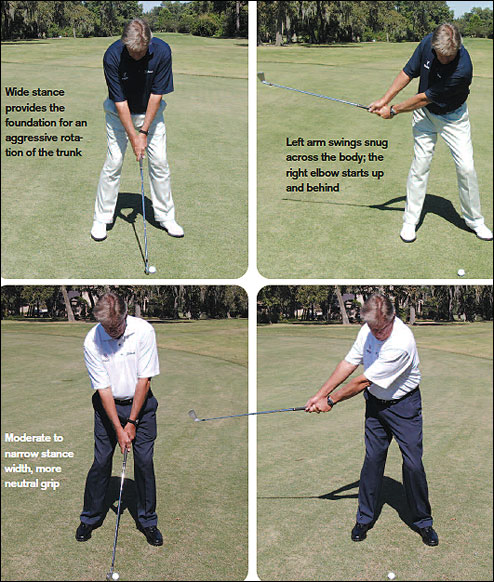Tuition
The Plane Truth
Part 3 – One & Two Plane Golf Swings – A rough guide
While every player will have their own nuances which will determine their precise instruction requirements, here is a quick summary of the chief characteristics of One and Two-Plane swings which create such an important distinction in Jim Hardy’s coaching vision.
Part 1 – Plane Talk – Interview with golf swing coach Jim Hardy
Part 2 – The Matrix & My Profile – A revolutionary vision for online golf instruction
Part 3 – One & Two Plane Golf Swings – A rough guide
Part 4 – Matt Kuchar – Natural Born One Plane Golf Swing
Part 5 – Leading Plane Truth certified pros in the UK give their verdict
Part 6 – In three balls you could cure your slice[octo_single_image image=”109833″ img_size=”full” alignment=”center”]One Plane Swings (blue shirt)
These players tend to have their spine more bent over at address, or bend over during the swing. Their shoulders rotate on a steeper plane than two-plane players, with their arms swinging up onto roughly the same plane as the shoulders rather than an independent plane. Hence the typical ‘rotary’ description of their swings. These players have less lateral shift (to the right) on their backswing, while their left arm does not disconnect from the chest as the club is swung more ‘around’ the body. As a result, at the top of the backswing, the arms are on a similar plane to that of the shoulders, and are not as high above the shoulders as two plane players. In the downswing, arms and body then rotate together, rather than exhibiting the two-plane swinger’s delay while the arms drop down on plane.
Two Plane Swings (white shirt)
These players tend to set up with their spine more upright, their arms hanging more vertically fromthe shoulders and with a stance closer to the ball than One-Plane players. Most distinctively, their arms swing independently of the rotation of their body. In the backswing, the arms move in a more upright plane, with the shoulders rotating on a relatively flatter plane. Typically, in order to create sufficient swing width, the left arm ‘disconnects’ from the left chest,while the body shifts slightly to the right. At the top of the swing, the arms typically drop down before the body can turn aggressively in the downswing. Through impact, and in the follow-through, the arms and club tend to mirror the backswing, staying in front of the body and swinging upward into a high finish over the left shoulder.
The Ball flight/impact test
While readers may well identify their physical swings in terms of these One Plane and Two Plane theoretical profiles, Hardy’s practical approach begins by analysing not the swing itself but the result of the swing – namely the nature of your impact and ball flight characteristics. Plane Truth instructors start by looking at whether the student’s swing is ‘shallow and wide’ or ‘steep and narrow’, and which of 15 typical ball/club contact and flight patterns that yields.
Only then do they progress to the swing itself, looking at the extent to which the ball flight and impact are consistent or inconsistent with the swing shape.
The Ball-flight/Impact analysis is crucial to Jim Hardy’s novel Plus And Minus system of applying a positive or negative number to each fault (and the corresponding fix) according to whether it implies a move that is steep (+1, +2, +3, etc) or shallow (-1, -2, -3, etc). The aim being to ‘net out’ with a neutral (0) impact position.[octo_single_image image=”26556″ img_size=”full” alignment=”center”][octo_single_image image=”26557″ img_size=”full” alignment=”center”][octo_single_image image=”26558″ img_size=”full” alignment=”center”][octo_single_image image=”26559″ img_size=”full” alignment=”center”][octo_single_image image=”26560″ img_size=”full” alignment=”center”][octo_single_image image=”26561″ img_size=”full” alignment=”center”]
